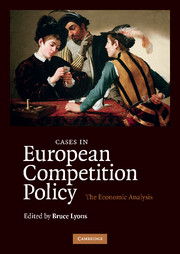Book contents
- Frontmatter
- Contents
- Contents by potentially anticompetitive business practices
- Contents by markets
- List of figures
- List of tables
- List of contributors
- Preface
- Introduction: the transformation of competition policy in Europe
- A Anticompetitive behaviour by firms with market power
- Introduction
- A.1 Abuse of a dominant position
- A.2 Market investigations
- 3 Mobile call termination in the UK: a competitive bottleneck?
- 4 Relationship between buyer and seller power in retailing: UK supermarkets (2000)
- B Agreements between firms
- C Mergers
- Bibliography
- Index
4 - Relationship between buyer and seller power in retailing: UK supermarkets (2000)
Published online by Cambridge University Press: 05 June 2012
- Frontmatter
- Contents
- Contents by potentially anticompetitive business practices
- Contents by markets
- List of figures
- List of tables
- List of contributors
- Preface
- Introduction: the transformation of competition policy in Europe
- A Anticompetitive behaviour by firms with market power
- Introduction
- A.1 Abuse of a dominant position
- A.2 Market investigations
- 3 Mobile call termination in the UK: a competitive bottleneck?
- 4 Relationship between buyer and seller power in retailing: UK supermarkets (2000)
- B Agreements between firms
- C Mergers
- Bibliography
- Index
Summary
Introduction
In October 2000, the UK Competition Commission (CC) reported on its fifteen-month ‘supermarkets’ market investigation. This monopoly inquiry examined the supply of groceries from multiple stores (specifically supermarkets in chains of ten or more outlets with store sales areas greater than 600 sq. metres), looking at both the procurement side and retailing side of the sector.
While by no means the first investigation of this sector, the 2000 report issued by the CC turned out to be a watershed in respect of the depth and type of analysis for a sector-wide inquiry in the UK. This included detailed analysis of the geographic and product/service dimensions of the relevant economic markets and examining in considerable detail the structure, behaviour and performance of these markets using relatively sophisticated empirical methods.
A notable feature of the inquiry was the examination of circumstances when oligopolistic firms hold both buyer and seller power but no single firm holds a dominant position. Thus, the inquiry allowed for consideration of how the two forms of power can interact and how they may individually and in combination affect competition at successive stages of a supply chain. It is this relationship between retailer buyer and seller power that is the main theme of this review of the CC's findings and policy recommendations, which centres on the leading retailers' pricing practices and relations with suppliers and their consequences for market outcomes.
- Type
- Chapter
- Information
- Cases in European Competition PolicyThe Economic Analysis, pp. 100 - 128Publisher: Cambridge University PressPrint publication year: 2009
- 1
- Cited by



